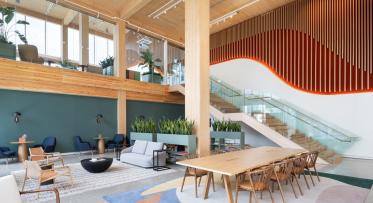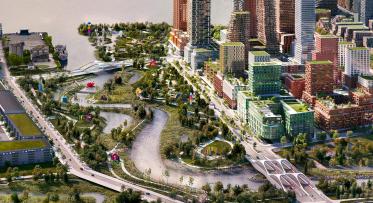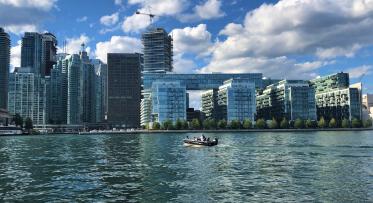Corktown Common a “Best of What's New” winner in Popular Science’s prestigious annual awards
Toronto, November 13, 2014 - Corktown Common has received international recognition from Popular Science magazine for its significant environmental and community impact.
Every year, Popular Science chooses 100 “Best of What’s New” winners from among thousands of entries around the world. “For 27 years, Popular Science has honoured the innovations that surprise and amaze us − those that make a positive impact on our world today and challenge our view of whatʼs possible in the future.” said Cliff Ransom, Editor-in-Chief of Popular Science. “The Best of Whatʼs New Award is the magazineʼs top honour, and the 100 winners − chosen from among thousands of entrants − each a revolution in its field.”
Corktown Common, Waterfront Toronto’s signature park in the emerging West Don Lands, was recognized in the Green Category for its sustainable design, and its positive and lasting impact on the community and the environment. Designed by Michael Van Valkenburgh Associates Inc., Corktown Common is a sophisticated landscape and ecological system that not only serves as a beautiful multi-use urban greenspace, but also as a critical piece of infrastructure that protects over 500 acres of Toronto’s downtown from flooding.
When asked what makes something stand out in the green category, Jennifer Bogo, Executive Editor of Popular Science, said “We most of all look for impact: Things that are poised to make a significant difference-- dramatically reduce energy use, cut waste, or otherwise leave the world a cleaner and more sustainable place. We also look for things that are truly innovative-- creative solutions to seemingly intractable problems. Corktown Common fit both of those criteria, while also turning an industrial area into a green space that benefits both people and wildlife.”
“It is an incredible honour for Corktown Common to be recognized by Popular Science” said John Campbell, President and CEO, Waterfront Toronto. “With Corktown Common we combined critical infrastructure with a high-quality community park which will deliver long-term environmental, social and economic benefits. This is a very prestigious award and confirms that leading revitalization efforts with the development of great parks and public spaces works.”
What Makes Corktown Common Innovative?
Corktown Common is more than just a beautiful park with spectacular views of the city’s skyline. It is a key part of the transformation of the West Don Lands from former industrial lands into a dynamic, sustainable and inclusive mixed-use community and has been a catalyst for neighbourhood regeneration and economic development.
Located atop the flood protection landform, Corktown Common was designed to take full advantage of the site’s unique topography and has leveraged essential public infrastructure to deliver a magnificent public amenity.
“Corktown Common provided my office with an unprecedented opportunity to transform a fallow brownfield along the Don River into a vibrant new neighbourhood park that builds upon a critical piece of flood mitigation infrastructure for Toronto’s new West Don Lands,” said Michael Van Valkenburgh, President and CEO, Michael Van Valkenburgh Associates Inc. “The coupling of these mutually supportive civic agendas further played out in the park with an aggressive sustainable agenda that includes an innovative water harvesting system unique to this site.”
At 7.3 hectares (18 acres), Corktown Common is the largest park in the area and one of the largest parks being built as part of waterfront revitalization. The park is ingeniously positioned atop the flood protection landform that protects more than 200 hectares (over 500 acres) of downtown Toronto – including a portion of the city’s financial district – from flooding. Utilizing the flood protection landform for a large community park is a creative and innovative use of vital infrastructure and another example of Waterfront Toronto’s approach to sustainable development.
“The compacted clay flood protection landform underlying the park required every drop of rainwater that lands on this park to be collected through a complex series of underground pipes,” said Van Valkenburgh. “This constraint became an opportunity for us to create a site-specific system that re-uses water multiple times to sustain the ecologically diverse native habitats we designed for the park, ranging from constructed wetlands to woodlands to prairielands, until the water is completely absorbed. We even diverted filtered grey water from the playground water feature to feed the perched marsh.”
The marsh is one of the ways the park reconnects the former industrial site with the native ecology of the region and is an essential part of the park’s onsite stormwater recycling system that will minimize the amount of potable water used for park maintenance. Photovoltaics located on the fireplace chimney at the Pavilion will reduce the park’s energy footprint. And, with more than 700 trees and thousands of shrubs, groundcovers, and aquatic plants Corktown Common is a diversely planted habitat that will encourage biodiversity.
High-quality parks and public spaces help create a sense of identity and place and are critical to the successful development of new neighbourhoods. By taking an abandoned, post-industrial site and turning it into a must-see destination, Waterfront Toronto has created a valued community asset that serves the new West Don Lands community and the surrounding area.
Corktown Common is located between Bayview Avenue and the GO/CN railroad lines, from King Street to the rail corridor in the south in the West Don Lands. The public can access Corktown Common from Bayview Avenue at Lower River Street or from the Don Valley Trail at the Bala Underpass.
The West Don Lands – a 32 hectare (80 acre) site being transformed from former industrial lands into a sustainable, mixed-use, pedestrian-friendly, riverside community - is one of the first communities being developed as part of waterfront revitalization.
Waterfront Toronto - The Governments of Canada and Ontario and the City of Toronto created Waterfront Toronto to oversee and lead the renewal of Toronto’s waterfront. Public accessibility, design excellence, sustainable development, economic development and fiscal sustainability are the key drivers of waterfront revitalization.
Great parks and public spaces are a vital part of the renewal of Toronto’s waterfront. Since 2004, Waterfront Toronto has opened 23 new or improved parks or public spaces.




